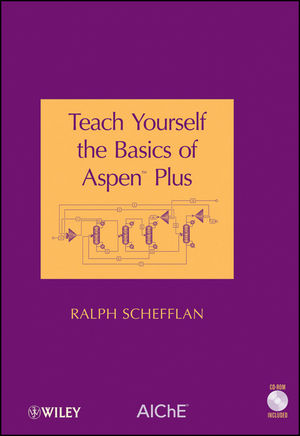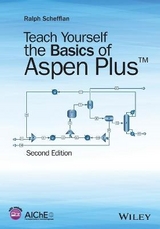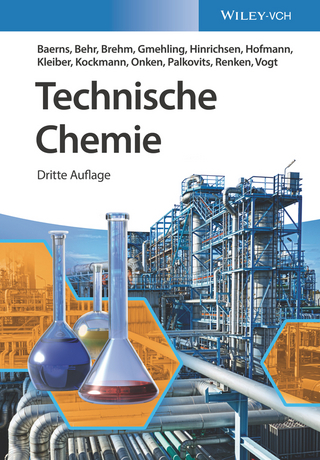
Teach Yourself the Basics of Aspen Plus
Wiley-Blackwell (Verlag)
978-0-470-56795-1 (ISBN)
- Titel erscheint in neuer Auflage
- Artikel merken
RALPH SCHEFFLAN has been an Adjunct Professor at Stevens Institute of Technology (SIT) for the past twenty-nine years. He has taught four graduate courses-thermodynamics, process simulation, numerical methods, and equilibrium stage operations-during his time there, as well as being SIT's representative to Aspen Technology. Dr. Schefflan introduced process simulation at SIT evolving from Flowtran to Aspen Plus. In his twenty-two years at Hoffmann-LaRoche he also introduced process simulation and was a founding member of the Flowtran Users Group.
PREFACE. 1 INTRODUCTION TO ASPEN PLUS. 1.1 Starting Aspen Plus. 1.2 Graphic Users Interface. 1.3 Next Button. 1.4 Setup Specifications Display. 1.5 Simulation Options. 1.6 Units. 1.7 Components. 1.8 Properties. 1.9 Streams. 1.10 Blocks. 1.11 Viewing Results. 1.12 Object Manager. 1.13 Plotting Results. References. 2 PROPERTIES. 2.1 Pure Component Data Banks. 2.2 Property Analysis. 2.3 Property Estimation. COPYRIGHTED MATERIAL. 2.4 Workshops. References. 3 THESIMPLEBLOCKS. 3.1 Mixer/Splitter Blocks. 3.1.1 Mixer Block. 3.1.2 Fsplit Block. 3.2 Simple Separator Blocks. 3.2.1 Sep Block. 3.2.2 Sep2 Block. 3.3 Some Manipulator Blocks. 3.3.1 Dupl Block. 3.3.2 Mult Block. 3.4 Workshops. 4 PROCESSES WITH RECYCLE. 4.1 Blocks with Recycle. 4.2 Heuristics. 4.3 Workshops. References. 5 FLOWSHEETING AND MODEL ANALYSIS TOOLS./b> 5.1 Introduction to Fortran in Aspen Plus. 5.2 Basic Interpreted Fortran Capabilities. 5.2.1 Primary Fortran Operators. 5.2.2 Precedence of Calculations. 5.2.3 Statement Format. 5.2.4 Program Logic Control. 5.3 Sensitivity Function. 5.4 Design Specification. 5.5 Calculator Function. 5.6 Transfer Function. 5.7 Workshops. References. 6 THE DATA REGRESSION SYSTEM. 6.1 Parameters of Equations of State. 6.2 Parameters of Activity Coefficient Equations. 6.3 Basic Ideas of Regression. 6.4 Mathematics of Regression. 6.4.1 Newton-Raphson Method for Solution of Nonlinear Equations. 6.4.2 Direct Optimization of an Objective Function. 6.5 Practical Aspects of Regression of VLE or LLE Data. 6.5.1 Regression of VLE Data. 6.5.2 Regression of LLE Data. 6.6 Workshops. References. 7 FLASHES AND DECANTER. 7.1 Flash2 Block. 7.2 Flash3 Block. 7.3 Decanter Block. 7.4 Workshops. References. 8 PRESSURE CHANGERS. 8.1 Pump Block. 8.2 Compr Block. 8.3 MCompr Block. 8.4 Pipelines and Fittings. 8.5 Workshops. Reference. 9 HEAT EXCHANGERS. 9.1 Heater Block. 9.2 Heatx Block. 9.3 Mheatx Block. 9.4 Workshops. References. 10 REACTORS. 10.1 RStoic Block. 10.2 RYield Block. 10.3 REquil Block. 10.4 RGibbs Block. 10.5 Reactions for the Rigorous Models. 10.5.1 Equilibrium Class. 10.5.2 Powerlaw Class. 10.5.3 Langmuir-Hinshelwood-Hougen-Watson Class. 10.5.4 Generalized-Langmuir-Hinshelwood-Hougen-Watson Class. 10.6 RCSTR Block. 10.7 RPlug Block. 10.8 RBatch Block. 10.9 Workshops. References. 11 MULTISTAGE EQUILIBRIUM SEPARATORS. 11.1 Basic Equations. 11.2 The Design Problem. 11.3 A Three-Product Distillation Example. 11.4 Preliminary Design and Rating Models. 11.4.1 DSTWU. 11.4.2 Distl. 11.5 Rigorous Models. 11.5.1 RadFrac. 11.5.2 Extract. 11.6 BatchSep. 11.7 Workshops. References. 12 PROCESS FLOWSHEET DEVELOPMENT. 12.1 Heuristics. 12.2 Example: The Production of Styrene. 12.3 A Model with Basic Blocks. 12.4 Properties. 12.5 Rigorous Flash and Decanter. 12.6 Analyzing the Rigorous Distillation. 12.7 Integrating the Rigorous Distillation Into the Flowsheet. 12.7.1 Selection of a Tear Stream. 12.7.2 Sequence of Calculations. 12.8 Reactor Feed. 12.9 Miscellaneous Considerations. 12.10 Workshops. Reference. 13 OPTIMIZATION. 13.1 Optimization Example. 13.2 Workshops. References. 14 COMPLEX EQUILIBRIUM STAGE SEPARATIONS. 14.1 Energy Integration Applications. 14.2 Homogeneous Azeotropic Distillation. 14.3 Extractive Distillation. 14.4 Heterogeneous Operations. 14.5 Workshops. References. INDEX.
| Erscheint lt. Verlag | 1.3.2011 |
|---|---|
| Zusatzinfo | Illustrations |
| Verlagsort | Hoboken |
| Sprache | englisch |
| Maße | 178 x 254 mm |
| Gewicht | 436 g |
| Themenwelt | Naturwissenschaften ► Chemie ► Technische Chemie |
| Technik ► Maschinenbau | |
| Technik ► Umwelttechnik / Biotechnologie | |
| ISBN-10 | 0-470-56795-3 / 0470567953 |
| ISBN-13 | 978-0-470-56795-1 / 9780470567951 |
| Zustand | Neuware |
| Informationen gemäß Produktsicherheitsverordnung (GPSR) | |
| Haben Sie eine Frage zum Produkt? |
aus dem Bereich



